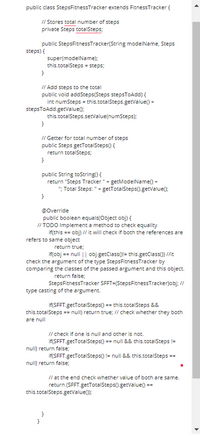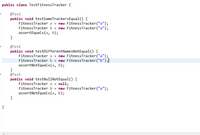
Urgent Quick Question
Write an equals method for the StepsFitnessTracker class that tests whether the one object is equal to another object that is passed as an argument (Object otherObject). The Object superclass provides an equals method that tests if two object references are equal. Your new equals method should override the Object equals method, and should test the following: • Return true if the current (this) object, and otherObject are identical references (hint: you can use the == operator for this). • Returns false if otherObject is null. • Returns false if the current (this) object and otherObject have different classes (hint: you can use the getClass() method provided by the Object superclass, see the Java 8 API documentation for details). • Casts otherObject to a StepsFitnessTracker, and tests for equality of each instance variable1 , if the instance variables are the same the method should return true. 1 To test for equality of each instance variable, you might want to also use the equals methods, which means that similarly to what has been suggested in this problem sheet, you would also override the default behaviour of the equals methods for each of the classes Distance, Steps, and HeartRate in your Problem sheet 1 package (uk.ac.sheffield.com1003.problemsheet1). Now write an equals method for the DistanceFitnessTracker and HeartRateFitnessTracker classes that: • Use the superclass equals method, and return false if this method fails. • Casts the parameter to either HeartRateFitnessTracker or DistanceFitnessTracker. • Tests for equality of the subclass instance fields. Please, use JUnit testing and write a test class named TestFTEquals to test that these new equals methods work properly. For inspiration, you can have a look at the test classes provided (TestFitnessTracker, TestDistanceFitnessTracker, TestStepsFitnessTracker, and TestHeartRateFitnessTracker) as they are already providing you some basic tests about how to test for equality of objects.
I already did the first part and added the equal method I need help to write the TESTFTEQUALS TEST PLease
public class HeartRateFitnessTracker extends FitnessTracker {
// Cumulative moving average HeartRate
HeartRate avgHeartRate;
// Number of heart rate measurements
int numMeasurements;
public HeartRateFitnessTracker(String modelName, HeartRate heartRate) {
super(modelName);
// Only one HeartRate to begin with; average is equal to single measurement
this.avgHeartRate = heartRate;
this.numMeasurements = 1;
}
public void addHeartRate(HeartRate heartRateToAdd) {
// Calculate cumulative moving average of heart rate
// See https://en.wikipedia.org/wiki/Moving_average
double newHR = heartRateToAdd.getValue();
double cmaHR = this.avgHeartRate.getValue();
double cmaNext = (newHR + (cmaHR * numMeasurements)) / (numMeasurements + 1);
this.avgHeartRate.setValue(cmaNext);
numMeasurements ++;
}
// Getter for average heart rate
public HeartRate getAvgHeartRate() {
return avgHeartRate;
}
public String toString() {
return "Heart Rate Tracker " + getModelName() +
"; Average Heart Rate: " + getAvgHeartRate().getValue() +
", for " + numMeasurements + " measurements";
}
@Override
public boolean equals(Object obj) {
// TODO Implement a method to check equality
if(this == obj) // it will check if both the references are refers to same object
return true;
if(obj == null || obj.getClass()!= this.getClass()) //it check the argument of the type HeartRateFitnessTracker by comparing the classes of the passed argument and this object.
return false;
HeartRateFitnessTracker HRFT=(HeartRateFitnessTracker)obj; // type casting of the argument.
return (HRFT.avgHeartRate == this.avgHeartRate);// comparing the state of argument with the state of 'this' Object.
}
}
public class DistanceFitnessTracker extends FitnessTracker{
private Distance totalDistance;
public DistanceFitnessTracker(String modelName, Distance distance) {
super(modelName);
this.totalDistance = distance ;
}
public Distance getDistance() {
return totalDistance;
}
public void addDistance(Distance distance) {
this.totalDistance.setValue(this.totalDistance.getValue() + distance.getValue());
}
public Distance getTotalDistance() {
return totalDistance;
}
public String toString() {
return "Distance Tracker " + getModelName() +
"; Total Distance: " + getTotalDistance().getValue();
}
@Override
public boolean equals(Object obj) {
if (this == obj) return true;
if (obj == null || getClass() != obj.getClass()) return false;
if (!super.equals(obj)) return false;
DistanceFitnessTracker that = (DistanceFitnessTracker) obj;
if(this.getDistance() == null && that.getDistance() != null) return false;
if(this.getDistance() != null && that.getDistance() == null) return false;
if(that.getDistance() != this.getDistance()) return false;
return that.getDistance().getValue() == this.getDistance().getValue();
}
}


Trending nowThis is a popular solution!
Step by stepSolved in 2 steps

- Java program Answer This question has more than one right answerarrow_forwardGoal 1: Update the Fractions Class ADD an implementation that takes an integer as a parameter. The functionality remains the same: Instead of multiplying/dividing the current object with another Fraction, it multiplies/divides with an integer. For example; a fraction 2/3 when multiplied by 4 becomes 8/3. Similarly, a fraction 2/3 when divided by 4 becomes 1/6. Goal 2: Update the Recipe Class Add a private member variable of type int to denote the serving size and initialize it to 1. Update the overloaded extraction operator (<<) to include the serving size. New Member functions to the Recipe Class: 1. Add four member functions get the value of each of the member variable of the Recipe class: getRecipeName(), getIngredientNames(), getIngredientQuantities(), getServingSize() They return the value of the respective member variables. 2. Add and implement a member function that scales the current recipe to a new serving size. The signature of this function is: void scaleRecipe(int…arrow_forwardTask 1:The first task is to make the maze. A class is created called Maze, in which a 2D array for the maze is declared. Your job is to implement the constructor according to the given javaDoc. When you completed this task, write a set of Junit test case to test your code.As you probably noticed, the maze is defined as a private variable. The second job for you is to write an accessor(getter) method that returns the maze. Other information about what is expected for this method is given in the starter code. public class PE1 { MazedogMaze; /** * This method sets up the maze using the given input argument * @param maze is a maze that is used to construct the dogMaze */ publicvoidsetup(String[][]maze){ /* insert your code here to create the dogMaze * using the input argument. */ }arrow_forward
- PROVIDE THE PYTHON SOURCE CODE FOR THE FOLLOWING Write a Circle class that represents the concept of a Circle as a tuple (x,y,r) where x and y are the centre and r is the radius of the circle. Create a circle object and Initialize the tuple values in the __init__() method Write a member function that takes another circle object and calculates the distance between self and the other circle object. i.e. Dist(x1,y1,x2y2) Write another member function that takes another circle object and checks whether the two circles collide or not. [Hint: If the distance between the centres of two circles is less than or equal to the sum of the radius of the two circles, then they are colliding. i.e. Dist(x1,y1,x2,y2) <= sum(r1+r2)]arrow_forwardOverview: A new bank wants to make a simple application to keep track of all accounts and transactions. it is required to help the bank manager implement the required application. Requirements: After a quick meeting with the bank manager, you got the following information: • tis required to store all bank accounts in one collection and all the transactions happened in another collection. Each account has a unique account number, a holder and balance. There is a specific prefix (common for all accounts) that should be added to the holder's civil id to create the unique account number. In addition, it is not allowed for a holder to have more than one account. Furthermore, only three transactions are allowed on any account: deposit, withdrawal and transfer money to another account. • Each holder has a unique civil ID (national id), a name and other attributes (add at least 2 attributes from your choice). • For each transaction, it is required to store the account(s) affected, amount of…arrow_forwardtri1 and tri2 are instances of the Triangle class. Attributes height and base of both tri1 and tri2 are read from input. In the Triangle class, define instance method print_info() with self as the parameter to output the following in one line: 'Height: ' The value of attribute height ', base: ' The value of attribute basearrow_forward
- 1. Create a Student class that implements the Person interface. As well as storing the students name and email, also store their course grade (e.g A, B, C) in a member variable. The grade should be accessible via a getGrade method. For the implementation of getDescription return a message along the lines of “A C grade student”, substituting the students actual grade.2. Create a Lecturer class that implements the Person interface. This class should also store the subject that the lecturer teaches. Add a getSubject method, and implement getDescription so that it returns a suitable message, e.g. “Teaches Biology”.3. Create a third class, Employee that implements the interface. This should also store the name of the department the Employee works in (available via getDepartment). Again, getDescription should return a suitable message.arrow_forwardTo overload constructors, we write multiple constructor declarations with the same signatures. True Falsearrow_forwardPLEASE WRITE THE CODE WITH USER ERROR AND ALL ACCEPTABLE ENTRIES!!!arrow_forward
- Write a method for the farmer class that allows a farmer object to pet all cows on the farm. Do not use arrays.arrow_forward1- is invoked to create an object. A A constructor B. The main method C. A method with a return type D. A method with the void return type 2- Suppose you wish to provide a getter for a double member gpa, what signature of the methad should be used? A. public void getGPA() B. public double getGPA() C. public boolean 1SGPA() D public void isGPA() 3- Suppose you wish to provide an accessor method for a Boolean property finished, what signature of the method should be used? A public int getFimished() B. public boolean isFinished) C public void isFinished() D public void getFinished()arrow_forwardGoal 1: Update the Fractions Class Here we will overload two functions that will used by the Recipe class later: multipliedBy, dividedBy Previously, these functions took a Fraction object as a parameter. Now ADD an implementation that takes an integer as a parameter. The functionality remains the same: Instead of multiplying/dividing the current object with another Fraction, it multiplies/divides with an integer (affecting numerator/denominator of the returned object). For example; a fraction 2/3 when multiplied by 4 becomes 8/3. Similarly, a fraction 2/3 when divided by 4 becomes 1/6. Goal 2: Update the Recipe Class The Recipe constructors so far did not specify how many servings the recipe is for. We will now add a private member variable of type int to denote the serving size and initialize it to 1. This means all recipes are initially constructed for a single serving. Update the overloaded extraction operator (<<) to include the serving size (see sample output below for an…arrow_forward
 Computer Networking: A Top-Down Approach (7th Edi...Computer EngineeringISBN:9780133594140Author:James Kurose, Keith RossPublisher:PEARSON
Computer Networking: A Top-Down Approach (7th Edi...Computer EngineeringISBN:9780133594140Author:James Kurose, Keith RossPublisher:PEARSON Computer Organization and Design MIPS Edition, Fi...Computer EngineeringISBN:9780124077263Author:David A. Patterson, John L. HennessyPublisher:Elsevier Science
Computer Organization and Design MIPS Edition, Fi...Computer EngineeringISBN:9780124077263Author:David A. Patterson, John L. HennessyPublisher:Elsevier Science Network+ Guide to Networks (MindTap Course List)Computer EngineeringISBN:9781337569330Author:Jill West, Tamara Dean, Jean AndrewsPublisher:Cengage Learning
Network+ Guide to Networks (MindTap Course List)Computer EngineeringISBN:9781337569330Author:Jill West, Tamara Dean, Jean AndrewsPublisher:Cengage Learning Concepts of Database ManagementComputer EngineeringISBN:9781337093422Author:Joy L. Starks, Philip J. Pratt, Mary Z. LastPublisher:Cengage Learning
Concepts of Database ManagementComputer EngineeringISBN:9781337093422Author:Joy L. Starks, Philip J. Pratt, Mary Z. LastPublisher:Cengage Learning Prelude to ProgrammingComputer EngineeringISBN:9780133750423Author:VENIT, StewartPublisher:Pearson Education
Prelude to ProgrammingComputer EngineeringISBN:9780133750423Author:VENIT, StewartPublisher:Pearson Education Sc Business Data Communications and Networking, T...Computer EngineeringISBN:9781119368830Author:FITZGERALDPublisher:WILEY
Sc Business Data Communications and Networking, T...Computer EngineeringISBN:9781119368830Author:FITZGERALDPublisher:WILEY





